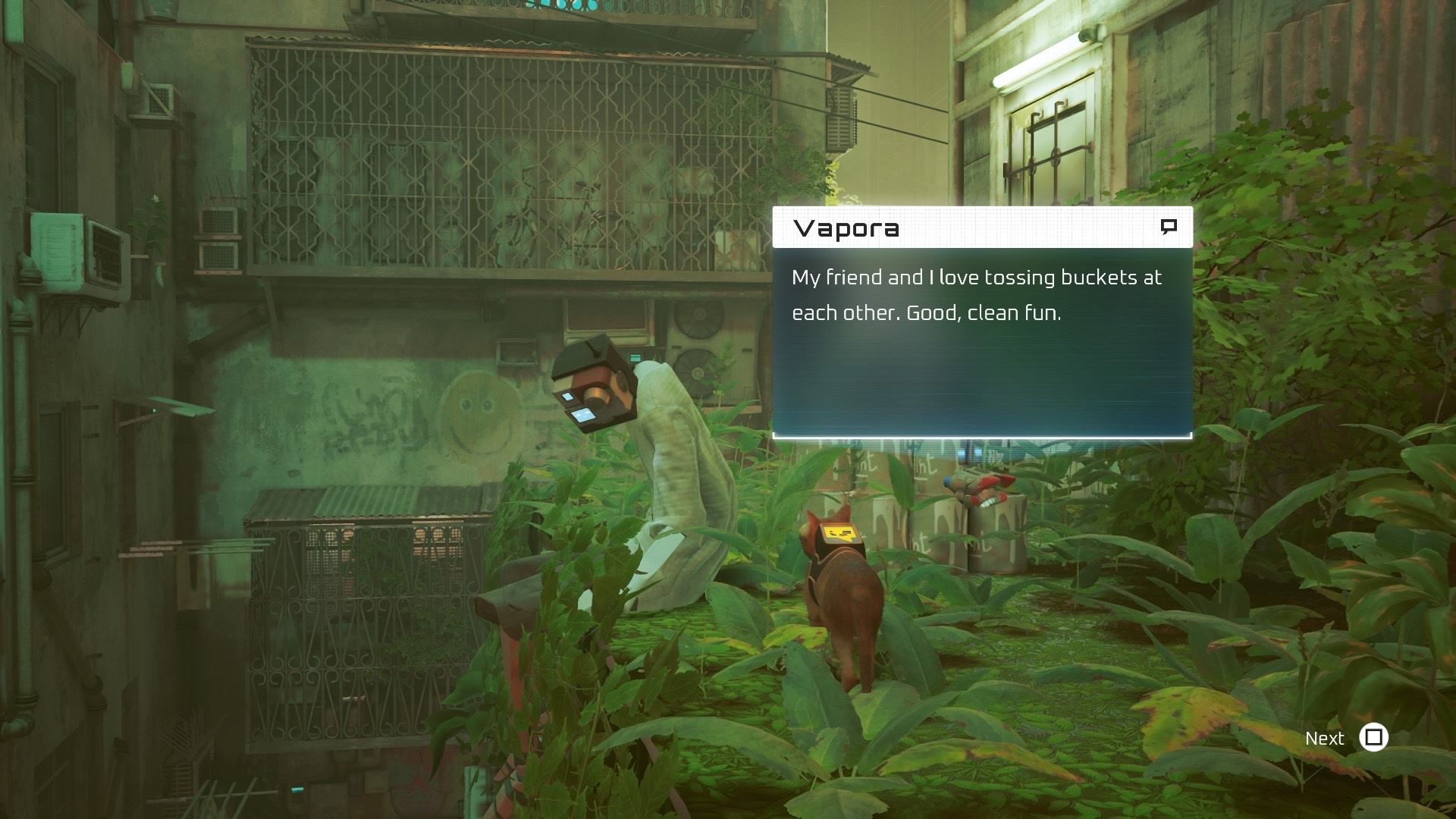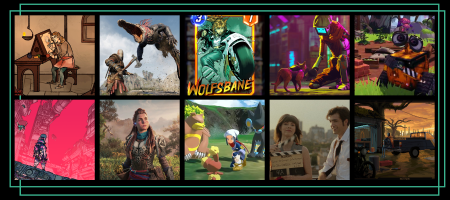Stray has one of the most delightful opening scenes I’ve ever seen—just cuddling up with three other cats, prowling around green-covered pipe-works.
The new game from BlueTwelve Studios with Annapurna Interactive succeeds most when it continues to let you do just that: Be a cat. It was so incredibly satisfying to jump on top of a tower of books, knock over a planting pot, rub against someone’s leg, scratch a carpet, and leap from one precarious position to another.
The game gave me a level of empathy for my cat that I’ve never had before. Ruining a piece of furniture was so enjoyable that I looked at my cat Zelda and was like, I get you, babe. I loved mashing the meow key and racing along rooftops, curling up in random spots with new friends. Stray encapsulates the independence and self-satisfaction of the outdoor cat.
Unfortunately, it also has a lot of… not cat stuff.

Goodbye Cats, Hello Robots
About 15% of the way into the game, the cat discovers an under-city of robots with emotions, some of which are convinced there is an “Outside.” The cat gets a drone companion, and ends up pursuing the big meta of the dead-humans-turned-robot civilization.
When the game moved into helping sentient robots—like a grandma who knits electrical cable ponchos (I want one)—escape their biohazard prison, I tried to keep an open mind. BlueTwelve Studio extends the same caring touch as it did for the cats as it does to the robots.
The robots have clever unique designs, funny personalities and comments, and different coping mechanisms. Even their apartments are unique beautiful little worlds to explore. The cat’s assistant, a drone named B12, provides a helpful translation and cultural bridge.

Trying Too Hard To Be a “Serious” Video Game
I was frequently exhausted when I felt Stray was weighed down by expectations of “what a video game is.” There are several occurrences with a hive-mind blob enemy I can only describe as icky. Myriad bacteria enemies chase the cat in straightforward platforming puzzles or short-but-urgent speedrunning levels. They’re stressful and not really fun, and I’m not sure why they’re there, to be honest, other than to add stress for stress’s sake.
It brings back the age-old question: Does a game have to have “combat” in order to be a game?
I don’t think so. I had hoped Stray’s gameplay would lean closer to the beautiful exploration of Abzû, or even the gentle clicking of Pokémon Snap. Those games are interactive experiences that encourage players to simply exist in the world, luxuriate in its wonders, and embrace the subtle joy of movement. Stray came close with a few bucket rides:
Oh, to be a cat in a bucket… #stray @annapurnapics @Hkdevblog pic.twitter.com/9Xmkx9ASsb
— Amanda Tien (she/her) (@amandajotien) July 26, 2022
Unfortunately, the emphasis on those creepy, panicked levels officially made it a game my mom can’t play, which bummed me out because she would’ve loved to play a cat game. And that wasn’t the only pitfall that Stray fell into.
There are story-related collectibles (of course there are) that are easy to miss (of course they are) on levels you can’t return to because even this cat can’t open a door on his own. Furthermore, Stray is weighed down by pacing problems, moving too slow in some sections and moving aggressively fast in others, resulting in late-game characters that aren’t as fleshed out as those I met earlier on. It felt like the game wanted to prove itself as exciting, always hustling me to the next section even when I was enjoying just poking around.

The World of Stray: Both Good and Bad
And it’s too bad, because Stray’s level design and music invite exploration, even if you don’t “find” much of anything. There are some side fun side quests, like gathering songs for a street musician or plants for kids who are growing their own greenhouse. Each level is meticulously, gorgeously designed with evidence of life—first from humans, then from robots.
The world of Stray is beautifully lit by neon signs, greenery, and… problematic Asian stuff. Which is too bad, because it’s a gorgeous space that didn’t need to fall into tropes.
I just wanted to play a cute cat game without the techno-orientalism. Unfortunately, Stray does not interrogate its creative influences at all. And from the moment that the developers decided to base their game off an enclave that was created by British colonialism, they had a responsibility to grapple with its history. Stray takes so much care in how it represents cats. I just wish it was as consistent about real humans’ legacies.
Sisi Jiang’s fantastic essay on the Orientalism in Stray, kotaku.com
The Problems With Stray‘s Story and Ending
The clash between Stray’s sweet story and its desire to fulfill certain ideas of video games came to a head for me at the end of a mid-game level. One robot friend, Momo, waited in a boat in an alley—even though we had just come back from rescuing one of his long lost friends. Six other robots came up to give him a hug, but no Momo.
Given all the loving care and touches that the game had given its robots so far, I was shocked the designers chose not to let Momo have a reunion with his bestie. It would’ve been easy to have Momo walk to the boat later, or fade to black and have him appear there after (storytelling tricks already leveraged elsewhere in the game). But no, before we have even returned from the rescue mission, Momo is already ready to go to shepherd the player to the next level of no return.
Stray put pressure on itself to be a capital-g Game throughout its storyline. It repeatedly emphasized a not-bad-but-a-bit-overdone story of Saving The Robot World Because All the Humans Are Dead Because of a Plague (Because Of Course They Are), when I think the game (and a lot of internet people) really just wanted it to live up to its moniker, “the cat game.”
Consider the game’s final moments (big spoilers) to see my point:
Is Stray a Good Video Game?
All in all, Stray left me feeling a little strange. I felt all of the above, but then I couldn’t help but smile any time I led the cat to slink under a sign, stick his head in a bag just to see what happened, or curl up on a pillow within an apartment library (dreamy!). Stray is as good a weekend binge as any, even if it failed my little cat-owner heart or made me grimace over rice paddy hats.
As a video game, Stray is far from perfect, but as a cat-riding-in-a-bucket simulator, it’s pretty incredible.

Score: 7.9/10
Amanda Tien (she/her or they) loves video games where she can pet dogs, punch bad guys, make friends, and have a good cry. She started writing for the site in 2020, and became an editor in 2022. She enjoys writing about mystery games, indies, and strong femme protagonists.
Her work has also been published in Unwinnable Monthly (click here to read her cover feature on Nancy Drew games), Salt Hill Journal, Poets.org, Litro Magazine, Public Books, and more. She was the Co-Founder and Editor-in-Chief of Columbia University's Culinarian Magazine, and served for two years as the Managing Editor of Aster(ix) Literary Journal.
She recently graduated with a MFA (Master of Fine Arts) in Creative Writing from the University of Pittsburgh. Her writing, art, graphic design, and marketing work can be viewed at www.amandatien.com.
She does not post a lot on social, but you can find her on X and on Instagram.










